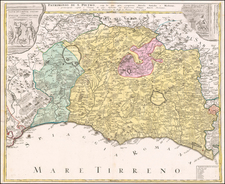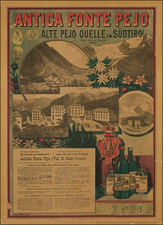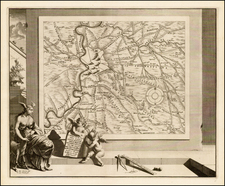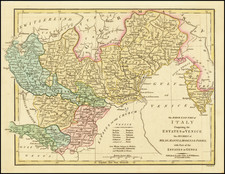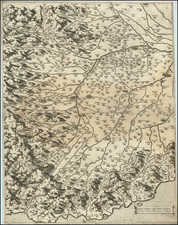Finely colored example of the Joannes Blaeu's map of the Duchy of Parma and Piacenza, first published in Amsterdam in 1640.
The Duchy of Parma and Piacenza was established in 1545 by Pope Paul III as a fief for his illegitimate son, Pier Luigi Farnese. The region had a rich and complex history marked by conflicts, shifting alliances, and cultural advancements. Situated in the fertile Po Valley, the duchy was strategically significant, influencing trade routes and military campaigns.
The map highlights several important rivers, most notably the Po River, which flows along the northern boundary of the duchy. The Po River was crucial for transportation and trade, linking the region to other parts of Italy and Europe. Other significant rivers include the Taro and the Trebbia, which flow through the duchy, supporting agriculture and local economies.
The Apennine Mountains are prominently depicted, showcasing the rugged terrain that defines much of the region's landscape. These mountains provided natural defense barriers and influenced settlement patterns and agricultural practices.
Parma, the capital city, has a rich history dating back to Roman times. Founded by the Etruscans and later a Roman colony, Parma became a significant cultural center during the Renaissance. The city was adorned with grand palaces, churches, and artworks commissioned by the Farnese rulers. Notable landmarks include the Parma Cathedral and the Baptistery, both renowned for their artistic and architectural splendor. By the mid-17th century, it was known for its cultural and intellectual contributions, including its famous university and thriving arts scene.
Piacenza, located on the banks of the Po River, played a critical role as a commercial and military hub. Its strategic location made it a focal point for trade and defense. Piacenza's origins trace back to Roman times, serving as an important junction on the Via Emilia. Throughout the medieval and Renaissance periods, the city was contested by various powers due to its strategic location. Piacenza's notable structures include the Piacenza Cathedral and Palazzo Farnese, both reflecting the city's historical importance. The city's history is marked by various occupations and conflicts, including its role in the struggles between the Guelphs and Ghibellines, and later, its incorporation into the Duchy of Parma.
Joan, or Johannes, Blaeu (1596-1673) was the son of Willem Janszoon Blaeu. He inherited his father’s meticulous and striking mapmaking style and continued the Blaeu workshop until it burned in 1672. Initially, Joan trained as a lawyer, but he decided to join his father’s business rather than practice.
After his father’s death in 1638, Joan and his brother, Cornelis, took over their father’s shop and Joan took on his work as hydrographer to the Dutch East India Company. Joan brought out many important works, including Nova et Accuratissima Terrarum Orbis Tabula, a world map to commemorate the Peace of Westphalia which brought news of Abel Tasman’s voyages in the Pacific to the attention of Europe. This map was used as a template for the world map set in the floor of the Amsterdam Town Hall, the Groote Burger-Zaal, in 1655.
Joan also modified and greatly expanded his father’s Atlas novus, first published in 1635. All the while, Joan was honing his own atlas. He published the Atlas maior between 1662 and 1672. It is one of the most sought-after atlases by collectors and institutions today due to the attention to the detail, quality, and beauty of the maps. He is also known for his town plans and wall maps of the continents. Joan’s productivity slammed to a halt in 1672, when a fire completely destroyed his workshop and stock. Joan died a year later and is buried in the Westerkerk in Amsterdam.









